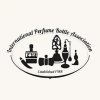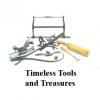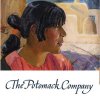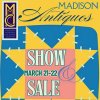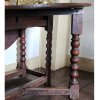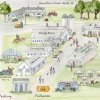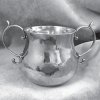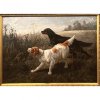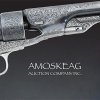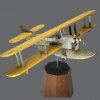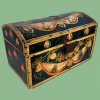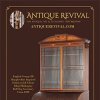The Winter Antiques Show 2016
January 21st, 2016
New York City
It is true that the Winter Antiques Show in New York City, held January 21-31, was more international and more contemporary than ever before. Date cutoffs were removed, and there were works by living artists. It is true that there were fewer dealers in Americana. Among the 73 dealers, just a dozen dealt in traditional American antiques, two with American prints and maps, and one of them was new to the show: toy dealers Gemini Antiques.

At the preview, the antique toy shop stand of Gemini Antiques, Oldwick, New Jersey, was like the old FAO Schwarz before Christmas.
Of the ten dealers in American paintings, one was new. Michael Altman installed a stunning stand of 20th-century American paintings joined with Flemish old masters presented by Paris dealer De Jonckheere, demonstrating that American paintings of the highest quality can stand up next to fine Flemish old masters from the 15th to 17th centuries. Quality is the theme of this show.
Americana dealers complained that advance publicity and the show brochure did little to promote Americana, once the major focus of this show. They said that early reviews featured ancient and modern works. That same small band of Americana dealers, nevertheless, did a lot of business. Some said it was their best show or one of their best shows ever, and others said they did twice as much as the year before.
“By Friday I had sold a dozen pieces of American furniture,” said Peter Eaton of Newbury, Massachusetts, who has a large following at the show. When asked if he sold to any new customers, he said, “No, but some I had not seen for a long time.”
Was it the momentum of all those years when everyone knew the Winter show was the place to find the finest Americana that dealers had saved all year for a grand unveiling? It is a tradition among the most passionate Americana collectors to come to New York City in January for Americana Week to watch the auctions and shop the Winter show.

Alexander Acevedo of Alexander Gallery, New York City, took frames off of all of his paintings, making the old seem modern, which made for a stunning stand. The Artist’s Recreation by Christian Schussele (1824-1879), circa 1859, 39" x 46", was $225,000. Acevedo called it, “The artist and his band of liberties,” and pointed out the players: “John [Adams], George [Washington], Ben [Franklin], Tom [Jefferson], and Alex [Hamilton].”
Dealers said that the crowd was diminished this year partly because some collectors did not think there were enough Americana dealers at the show to make it worth the trip. It is not that the management did not try to get more Americana dealers; they did, and failed. It is just too expensive for some dealers in American furniture and folk art to show here. Moreover, some of the finest American works are sold privately by agents, who do not have an inventory, through auctioneers.
The Americana dealers who showed in New York this year did brisk business at the preview party on Thursday and again on Friday, but some collectors who came early in the week for the auctions (several were held before the show opened) left the city early on Friday when there was a threat of a blizzard. And with a blizzard in the forecast some canceled their plans to come to New York at all. Some who stayed for the weekend were told not to leave their hotels while two feet of snow was falling, and all surface traffic was banned starting at 2:30 p.m. on Saturday.

C.L. Prickett, Yardley, Pennsylvania, offered formal American furniture and an Edward Redfield (1869-1965) painting, Blossom Time. The figured mahogany serpentine-front, bonnet-top secretary desk with pinwheel rosettes, spiral finials, a carved sunburst on the scroll board, paneled doors with scalloped inside borders, and fluted pilasters, all original except the brasses and valances over the letter holes, was $195,000.The tall-case clock in a carved cherrywood case has a brass dial inscribed “Isaac Brokaw,” Elizabethtown or Bridgetown, New Jersey, 1770-85; the lack of a date or name of a town indicates early production. With an Israel Sack provenance, it was $58,500.The Hepplewhite sideboard was made in New York, 1790-1810, and was $95,000. The pair of Philadelphia walnut four-shell side chairs, circa 1775, was $46,500. The Philadelphia Queen Anne mahogany dish-top candlestand with birdcage and suppressed ball-and-ring standard, pad feet, and mellow surface, circa 1760, was $18,500.
Nevertheless, the show opened at noon during the blizzard with a skeleton crew. Food was served, about 500 shoppers found shelter in the armory, and business was done until the doors closed early at 6 p.m. instead of at 8 p.m. In the middle of the storm, Robert Schwarz of Schwarz Gallery sold a Hermann Herzog painting of a glacier. One dealer reportedly made six sales.
Some out-of-town collectors stayed in New York City for the week and went to museums, Broadway shows, and auctions, and came back to the show many times and bought. You can’t see this show or even everything on the stands of the few dealers in Americana in one visit. Post-blizzard sales were slow for most dealers, though the toy-dealing Weiss twins, who call their business Gemini Antiques, said they sold every day. Designer David Guilmet created their stunning stand, setting off their toys on white-painted shelves. They also published a catalog, and they sold and sold. On opening night their stand was like the old FAO Schwarz before Christmas. “By the end of the show we had made more than fifty sales, a dozen to new customers,” said Leon Weiss. “We bought toys and saved toys for the show and took toys on consignment that had been off the market for thirty years.”
Kelly Kinzle of New Oxford, Pennsylvania, showing for the second time at the Winter show, thinks the show has magic. “A woman came in on Tuesday night and said she had been to the preview party but had not gotten as far as my booth at the back of the show, but she saw my ad in the catalog and wanted the fox weathervane because her house was called Fox-something, and she came back to the show and bought it,” he said. Kinzle said that sale made his show. The price on the tag was $550,000. “She knew what she was buying; she was a seasoned collector who knew all about weathervane manufacturers,” he said.
 Kinzle sold a lot more: a painted box, a face jug, an Ohio painted blanket chest, a serpentine chest with blocked ends made in New England, attributed to Benjamin Frothingham, a cherry table, a fire hat, and a painting of George Washington, after a Thomas Sully portrait, on a painted tin panel from a fire truck. “The painting of Washington went to Mount Vernon,” he said.
Kinzle sold a lot more: a painted box, a face jug, an Ohio painted blanket chest, a serpentine chest with blocked ends made in New England, attributed to Benjamin Frothingham, a cherry table, a fire hat, and a painting of George Washington, after a Thomas Sully portrait, on a painted tin panel from a fire truck. “The painting of Washington went to Mount Vernon,” he said.
Elliott and Grace Snyder, David Schorsch, Tillou Gallery, and Frank Levy of Bernard & S. Dean Levy reported multiple sales at the show and more in the days after the show closed. “This show isn’t over until April,” said Levy, who said he made two new customers.
American paintings dealers sold well too. Jonathan Boos had half a dozen sales, and Hirschl & Adler sold furniture, paintings, ceramics, and glass. “The best Americana is still singing strong,” said Elizabeth Feld of Hirschl & Adler. “I am tired of people saying there is no market for American furniture and decorative arts. The Winter show dealers are a special cast of characters, longtime experts who bring the best they can find year after year; it has its own brand.”

This large (32¼" x 38¼") silk embroidered memorial, worked by Sarah Kuhn at aged 19, depicts three figures dressed in mourning costume standing on both sides of a monument. The figures probably represent Sarah and her parents. The plinth is inscribed, “In Memory of Daniel Kuhn,” who died October 23, 1810, at age seven. Sarah, who lived on Cambridge Street in Boston, was the oldest of ten children born to John Kuhn and Sarah Lapham. She completed this elaborate memorial to her younger brother in 1812, two years after his death, and also got married the same year. She married George Fuller, and they had eight children. It was $22,000 from Stephen and Carol Huber of Old Saybrook, Connecticut.
It appeared that old guard Americana collectors respond to this brand, and they are very important to this show that has become more and more international. Nineteen exhibitors came from abroad, and some of them offered things that stopped showgoers in their tracks. Aronson of Amsterdam brought giant Dutch Delft tulip vases with pink tulips (they sold). Daniel Crouch of London brought a Chinese map of the Everlasting Unified Qing Empire, 1811, that looked like a large contemporary abstract painting. The stand of Didier Ltd., London, was filled with jewelry by painters, sculptors, architects, and designers and was outstanding. London dealer Apter-Fredericks designed a stand with simulated floor-to-ceiling windows with a view of the New York City skyline as a setting for fine Georgian furniture. It was voted the best-designed stand, and the dealer sold well.
The preview party is always a highlight of the social season in New York City. More than 2000 came this year to celebrate the 125th anniversary of the East Side House Settlement, which supplies social services to the South Bronx.

The circa 1785 three-quarter-length folk portrait of a young girl with a basket was attributed to American artist Abraham Delanoy Jr. (1742-1795) and priced at $85,000 in the booth of Peter Eaton and Joan Brownstein of Newbury, Massachusetts. It’s early for an American folk portrait, and the attribution is based on Delanoy’s portraits of the family of John Sherman of Connecticut (the artist was once referred to as the “Sherman Limner”). Two portraits of the Sherman family have been lost, and it’s possible this is one of them. The paint-decorated press cupboard was made in Hampton, New Hampshire, 1720-30, and was tagged $145,000. Both sold on opening night.
As this show adapts to the 21st century, it is bound to change. Dealers see it as a show in transition. It will go on. Catherine Sweeney Singer, the director, said that East Side signed a five-year lease with the armory and has loan shows lined up for the next five years. (This year’s loan show featuring the Wadsworth Atheneum Museum of Art was one of the best ever, and the article in the catalog by Jay Cantor spells out the “Legacy for the Future” of the oldest continuously running public art museum in existence in the U.S. The show should lure many to Hartford, Connecticut.)
Dealers said they are expecting a raise in booth rent next year, and if it is too high they will have to decide if showing in New York is a good business plan. They say it costs a minimum of about $45,000 to do the show, and although prices of antiques are down from their record highs, the highest-quality works are still expensive. The Winter show has long been about the highest quality; it is where authenticity is a selling point, history matters, and aesthetics reign supreme.

Apter-Fredericks Ltd., London, installed fine English furniture in a setting replicating a New York City apartment with floor-to-ceiling windows with city views. The dealer sold well.
Dealers are afraid that the show was marketed as style and design. They were surprised that New York City dealer Todd Merrill, new to the show, sold and took orders for bespoke furniture and decorations. Singer said that is no different than leaving a sold item in a booth so that those who missed it can ask the dealer to look for one similar. Some worry that the next Winter show will follow the first show produced by the TEFAF/Artvest partnership that, like the Winter show, will offer works from antiquity to the present. It replaces the Haughtons’ International show at the armory in October, which for 28 years set the standard for elegant show design and masterworks. TEFAF is expected to take antiques and art fairs in the U.S. to a higher level of quality and expense. Singer said she looks forward to the formidable competition.
“The fact that Maastricht [TEFAF] is coming to New York has the potential to reinvent a show once a leader in the U.S., and it will make us better. We will have to try harder. The October show will fill a needed slot, and its arrival in New York puts to rest the idea that the armory does not want antiques shows that circulated when the Palm Beach group was denied a contract of its fall show,” Singer said. Many dealers need more than one stay in New York, and there have always been dealers who showed at both the Haughtons’ International show and the Winter show. Although the Winter show has had a turnover of 21 dealers in the last two years, Singer does not expect that trend to continue.
The Winter Antiques Show is one of the last of the shows at the Park Avenue Armory that raises a substantial amount of money for charity. TEFAF will benefit the performances and exhibitions at the Park Avenue Armory.
Come to think of it, an antiques show is, in a way, a cross between performance art and installation art, and its star performers are a group of dealers who have a story to tell.
For more information, go to the Winter Antiques Show website (www.winterantiquesshow.com).

Sir Alexander Mackenzie’s pipe tomahawk of hickory, steel, silver, and brass, with a leather sheath with woven strap, inscribed “AM” for Alexander Mackenzie, 18" long, blade 5½" wide, was carried across Canada in 1793 by explorer Mackenzie when he reached the Pacific Ocean over land, preceding Lewis and Clark’s similar expedition by 12 years. It was offered along with the original sheath and Mackenzie’s journal, published in 1801, for $450,000 by Kelly Kinzle. “In 1792 Mackenzie started out from Vancouver and took a right and found the Pacific Ocean,” said Kelly Kinzle. The Mackenzie River is named for him.

This battleship New York, an electric-powered toy made by Märklin in Germany circa 1908, was $135,000 from Gemini Antiques. This is a fine example of Märklin’s commitment to quality and detail. The Weiss twins said although there was not a battleship New York in the Great White Fleet that circumnavigated the globe from 1907 to 1909, this toy was made at a time when Teddy Roosevelt said America should “speak softly and carry a big stick.”

This carved and painted wedding scene, 1900-20, maker unknown, was found in Massachusetts. The 17 painted figures are made of wood with fabric clothing; the altar and pots of strawflowers, the Bible, and the pews are unpainted wood. It was $38,500 from Barbara Pollack and got a lot of attention at the show.

Tillou Gallery offered a collection of early ice skates and sold several pairs. This pair of 19th-century American
skates with curled blades attached to platforms and the leather shoe keeper straps intact was $6800. Another pair was $6800, and others with curled prows, not as pristine, were $2350.
Originally published in the April 2016 issue of Maine Antique Digest. © 2016 Maine Antique Digest
